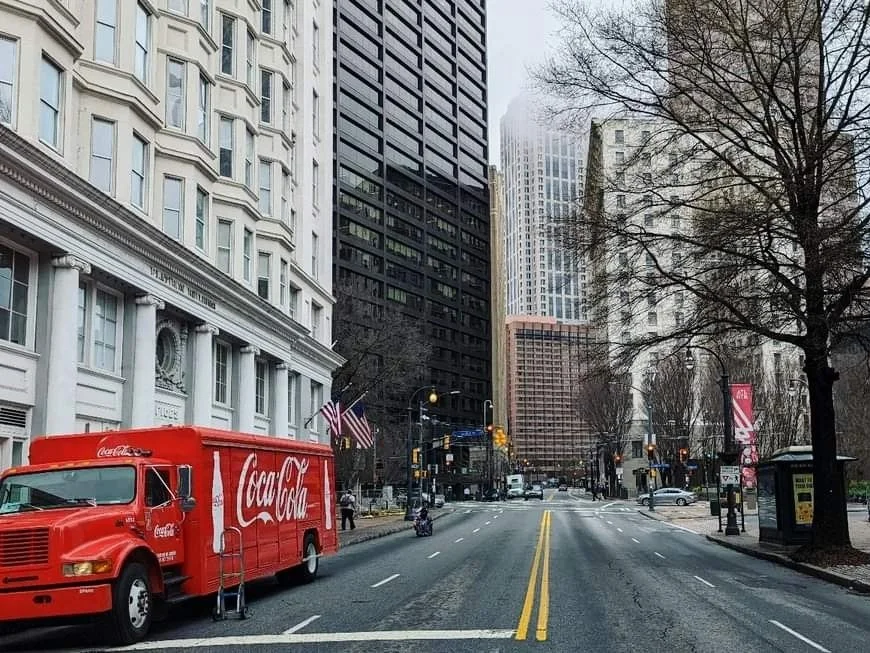Where is Atlanta's Freight Plan?
Guest post by Sandra Rothbard
June 18, 2024
With e-commerce on the rise, a construction boom, and a rapidly growing population, there has never been a greater need or a better time for Atlanta to develop a plan for last-mile freight. The city and region are working hard on numerous planning and transportation efforts, but there is little attention given to urban logistics.
Almost ten years ago Atlanta conducted a citywide freight study to assess the state of goods movement in the city and highlight specific physical infrastructure improvements that could be made, along with higher level recommendations, but very little has been done since. Atlanta’s Comprehensive Development Plan “Plan A” is currently undergoing an update as is the city’s zoning plan. In addition, ATLDOT recently launched the city’s first Vision Zero Action Plan and has also developed a Tactical Urbanism Guide.
Over the last couple of years the Department of City Planning conducted a NW Atlanta Industrial Area Freight Study focused on a limited part of the city and on industrial space specifically. Unfortunately, these plans largely ignore the last-mile movement of goods that is happening on our local streets citywide every day. And while the upcoming Atlanta Regional Freight Mobility Plan due this fall does focus on goods movement, it does so from a 20 county level or specifically at local freight clusters as individual networks. The Atlanta Regional Commission (the agency responsible for the plan) is tasked with looking at this issue from a broad regional level and it is not their charge to focus specifically on last-mile delivery in Atlanta.
A citywide strategy for how to move forward with plans, programs and policies for last-mile freight citywide remains absent.
For too long, municipalities have excluded freight policy in their transportation and land use planning efforts. It is often seen as a blight, something to scoff at or neglect instead of a vital service we need to support. Local governments often mistakenly believe freight is largely a private industry, when in fact it involves the movement of all of our goods: the everyday items we eat, clothing we wear, medication we take, objects delivered to commercial businesses, building materials, waste and service equipment (items used by a plumber, electrician, etc.).
All of this requires a strategy for infrastructure, rules, and regulations. The consequences of ignoring these needs are felt every day in Atlanta, with quality of life, safety, economic, and environmental impacts:
● Poor street design and enforcement causes double parked trucks and deliveries in bike lanes.
● A lack of curb management strategies causes increased costs and lost productivity for businesses struggling to receive efficient deliveries and customers waiting for products.
● Few transportation options to industrial and commercial areas result in dangerous commutes for workers to freight facilities.
● Highways and warehouses located near vulnerable communities lead to disproportionate impacts from air and noise pollution on minority and low income residents.
● Poorly maintained roads and sidewalks cause damaged cargo, and lead to driver, pedestrian, and cyclist injuries.
Delivery inefficiency along the BeltLine is one example of the consequence of failing to consider freight in an otherwise worthwhile project. Many restaurants, bars, and shops have their main access directly off the pedestrianized path with no connection to vehicle loading/unloading zones.
On a recent visit I spoke with a delivery person struggling to move their hand truck stacked with beer. They told me that there is limited parking available for trucks and that once a vehicle is parked, delivery drivers have to go out of their way to find an available ramp or operational elevator.
There is potential to prevent bad freight planning in the future with upcoming projects like the Five Points MARTA Station Transformation and The Stitch. And while including freight in individual development design is important, it is critical to connect this to a larger comprehensive strategy throughout the city.
1. The Exchange Zone is a hyperlocal delivery locker system from Relai that is being deployed across the US including Atlanta.
2. UPS (like many carriers) includes a significant number of electric vehicles in their fleet
3. Fulpra is a Dutch cargo bike company that supports the use of micro-mobility for last-mile delivery. The cargo bike market is growing significantly abroad and is starting to gain traction in the US.
4. NYCDOT manages a program called "off-hour deliveries" where businesses receive goods from 10 pm - 6 am to avoid other road users, reduce congestion and ensure availability for loading/unloading at the curb.
Atlantans (both government and transportation advocates) must not consider freight an afterthought. Changes to zoning, street design, building requirements, and more are needed to make city logistics safer and cleaner, and it will take multiple partners to come together and design a comprehensive last-mile delivery plan. Taking advantage of the momentum of upcoming development projects and current land use and transportation efforts AND working to ensure that freight has a more prominent place within those plans is critical to addressing all the issues described above. Atlanta, there is no better time to do it.
Sandra Rothbard, AICP is an urban planner and expert in freight transportation. She runs Freight Matters, a consulting firm that supports public, private and non-profit clients around the world on all issues related to sustainable and resilient city freight. You can follow her on Twitter/X at @freight_matters



